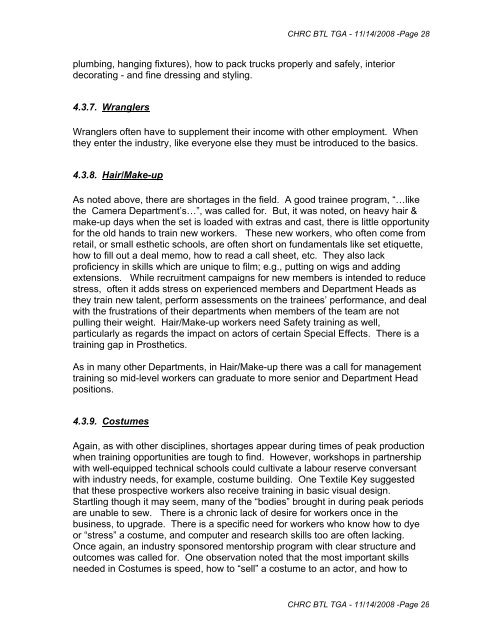Below-the-Line Film and Television Workers - Conseil des ...
Below-the-Line Film and Television Workers - Conseil des ...
Below-the-Line Film and Television Workers - Conseil des ...
- No tags were found...
Create successful ePaper yourself
Turn your PDF publications into a flip-book with our unique Google optimized e-Paper software.
CHRC BTL TGA - 11/14/2008 -Page 28plumbing, hanging fixtures), how to pack trucks properly <strong>and</strong> safely, interiordecorating - <strong>and</strong> fine dressing <strong>and</strong> styling.4.3.7. WranglersWranglers often have to supplement <strong>the</strong>ir income with o<strong>the</strong>r employment. When<strong>the</strong>y enter <strong>the</strong> industry, like everyone else <strong>the</strong>y must be introduced to <strong>the</strong> basics.4.3.8. Hair/Make-upAs noted above, <strong>the</strong>re are shortages in <strong>the</strong> field. A good trainee program, “…like<strong>the</strong> Camera Department’s…”, was called for. But, it was noted, on heavy hair &make-up days when <strong>the</strong> set is loaded with extras <strong>and</strong> cast, <strong>the</strong>re is little opportunityfor <strong>the</strong> old h<strong>and</strong>s to train new workers. These new workers, who often come fromretail, or small es<strong>the</strong>tic schools, are often short on fundamentals like set etiquette,how to fill out a deal memo, how to read a call sheet, etc. They also lackproficiency in skills which are unique to film; e.g., putting on wigs <strong>and</strong> addingextensions. While recruitment campaigns for new members is intended to reducestress, often it adds stress on experienced members <strong>and</strong> Department Heads as<strong>the</strong>y train new talent, perform assessments on <strong>the</strong> trainees’ performance, <strong>and</strong> dealwith <strong>the</strong> frustrations of <strong>the</strong>ir departments when members of <strong>the</strong> team are notpulling <strong>the</strong>ir weight. Hair/Make-up workers need Safety training as well,particularly as regards <strong>the</strong> impact on actors of certain Special Effects. There is atraining gap in Pros<strong>the</strong>tics.As in many o<strong>the</strong>r Departments, in Hair/Make-up <strong>the</strong>re was a call for managementtraining so mid-level workers can graduate to more senior <strong>and</strong> Department Headpositions.4.3.9. CostumesAgain, as with o<strong>the</strong>r disciplines, shortages appear during times of peak productionwhen training opportunities are tough to find. However, workshops in partnershipwith well-equipped technical schools could cultivate a labour reserve conversantwith industry needs, for example, costume building. One Textile Key suggestedthat <strong>the</strong>se prospective workers also receive training in basic visual <strong>des</strong>ign.Startling though it may seem, many of <strong>the</strong> “bodies” brought in during peak periodsare unable to sew. There is a chronic lack of <strong>des</strong>ire for workers once in <strong>the</strong>business, to upgrade. There is a specific need for workers who know how to dyeor “stress” a costume, <strong>and</strong> computer <strong>and</strong> research skills too are often lacking.Once again, an industry sponsored mentorship program with clear structure <strong>and</strong>outcomes was called for. One observation noted that <strong>the</strong> most important skillsneeded in Costumes is speed, how to “sell” a costume to an actor, <strong>and</strong> how toCHRC BTL TGA - 11/14/2008 -Page 28










